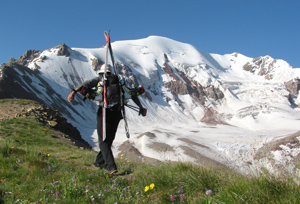 Spring arrives at different time in different years. Some of us finish the last race of the season in February or March and are ready to hang up the skis. Others, with sufficient snow or motivation, are able to push the ski season well into May or even beyond.
Spring arrives at different time in different years. Some of us finish the last race of the season in February or March and are ready to hang up the skis. Others, with sufficient snow or motivation, are able to push the ski season well into May or even beyond.
Regardless, at some point most of us have to pack the skis away for the summer and switch to dryland training.
In this article, we want to provide you with a some tips and cover a couple of key things to keep in mind when you switch to summer training.
Equipment
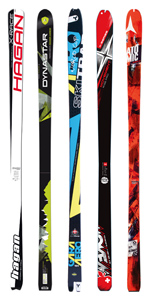 Make sure to take take care of your equipment:
Make sure to take take care of your equipment:
- Put a layer of warm (yellow or white) storage wax on your skis and leave them un-scraped. This will prevent the bases from oxidizing over the summer.
- Remove the batteries from your beacon and store it properly with the battery compartment open (so if you do grab it, you will remember to put new ones in).
- Wax your skins and apply them to a glue-saver plastic backing for long term storage.
- Make a list of gear that needs to be replaced or repaired and take advantage of end of the season sales. Three specialized skimo stores we recommend are:
- Skimo.co – http://skimo.co/
- Cripple Creek BC – http://www.cripplecreekbc.com/
- Boulder Nordic Sports – https://www.bouldernordicsport.com/shop/c-377-alpine-touring.aspx
Transition Gently
Skimo racers are all about fast transitions but it is never a good idea to immediately jump right into training for another sport.
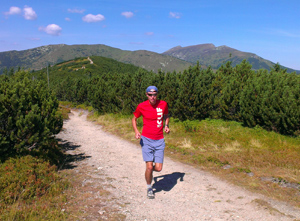 Most of us are runners or cyclists in the summer and it may be tempting on your first run or ride to try to hit the same volume as when you ended the previous summer.
Most of us are runners or cyclists in the summer and it may be tempting on your first run or ride to try to hit the same volume as when you ended the previous summer.
In an ideal scenario, as the ski season is winding down, you will start to mix in a few easy runs and rides throughout the week to fill in as the ski days dwindle. This is the best way to ease into your new season and to avoid injury.
Take Downtime of 2-3 weeks
While ski touring does not have the high-impact component that running does, it is still hard on our bodies in a different way. With running, it is likely that an athlete will experience musculoskeletal injuries or at least will feel sufficiently beat up to take some rest. Skimo athletes, due to the nature of the sport, are less likely to experience such injuries or symptoms, therefore, are able to push their bodies further towards overall fatigue and overtraining. Because of this, it is especially important to take several weeks of rest at the end of your ski season.
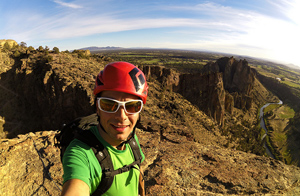 During downtime, we advise athletes to ‘move’ but don’t ‘train’. Fun, easy runs and rides are good if your body feels up to it but even better is to get out and enjoy nature in a different way for a little while – rock climb, paddle, or just hike. Once your mandatory two weeks have passed, consider a third based on how you feel.
During downtime, we advise athletes to ‘move’ but don’t ‘train’. Fun, easy runs and rides are good if your body feels up to it but even better is to get out and enjoy nature in a different way for a little while – rock climb, paddle, or just hike. Once your mandatory two weeks have passed, consider a third based on how you feel.
Downtime is also important for mental well-being. At the end of the season, most of us are pretty tired of ’training’. Time away from your (racing) sport will allow you to remember why you love them, and by the end of your rest period you should be itching to get back on your bike or lace up your shoes! If not, reevaluate your situation and perhaps seek an experienced coach to help you out
Write your Annual Training Plan!
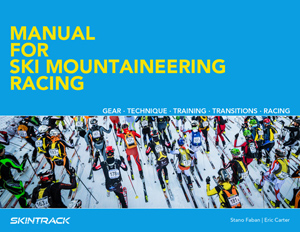 With the spare time you will have in your downtime block, it is the perfect time to develop your Annual Training Plan (ATP). This process is detailed in SkinTrack Manual for Ski Mountaineering Racing so take a look there for more information.
With the spare time you will have in your downtime block, it is the perfect time to develop your Annual Training Plan (ATP). This process is detailed in SkinTrack Manual for Ski Mountaineering Racing so take a look there for more information.
By planning your next season during the rest period, you give yourself the benefit of an entire year to prepare rather than deciding things in a rush as you go.
Keys points for creating your summer training plan:
- Long slow distance training is the key to developing a successful base for ski mountaineering. The mode (running or cycling) is less important but the hours are.
- Mountain running should be used instead of flat running whenever possible to help maintain muscle strength necessary for climbing and downhill skiing.
- Choose a summer race schedule that complements your skimo training. This means races of similar duration and terrain (1-3 hours with significant vertical gain and descent). While ultra-marathons may be the sexy events of trail running right now, they are not the ideal way of preparation for skimo racing for most of us.
- Stano and I personally find it difficult to get in the strength room at the beginning of the summer. It is just too nice outside to “waste energy” inside. That being said, strength is an important component. Plan to start strength training mid-summer and continue through the fall and early winter.
- Take time for some adventures. Just like during the winter, it is important to get away from racing and explore the backyard. Plan some long days in the mountains to practice your technical skills and endurance, and you will see the benefits when winter returns.
Takeaway Points
- Deal with gear issues and store it properly.
- Take two to three weeks downtime with no ‘training’.
- Plan your summer and next season.
- Train hard and wise – make the summer count!


Stano Faban says
Awesome! If possible, try to make them not much heavier than about 1.2kg per ski, otherwise, your stride frequency will be too slow for truly effective training. But either way I will stop by this summer to ride them 🙂
steve0 says
No…. truly off road. Using off road pnuematic oversize skateboard wheels. Heavy, but they’ll be awesome.
Stano Faban says
Hi Steve. You mean for off-road? Cause otherwise all you need to do is mount a pair of classic skis with a tech toe piece, but you know that I bet 😉
steve0 says
Hi Stano. My off season project: build skimo roller skis. It’s been a long project and I’m finally picking it up again and should finally get ’em done. I’ll post something on my website soon!